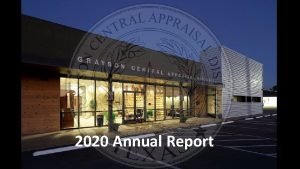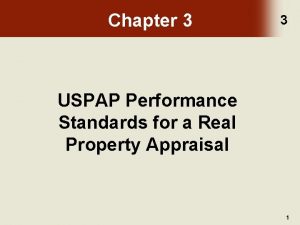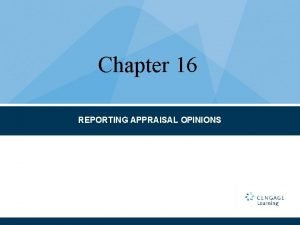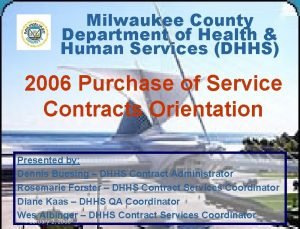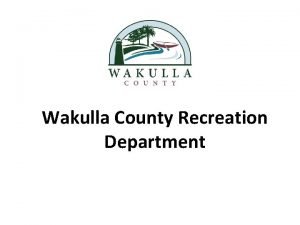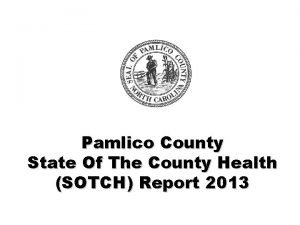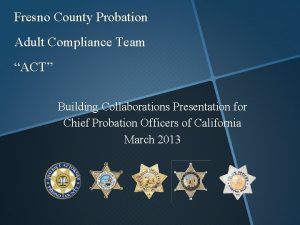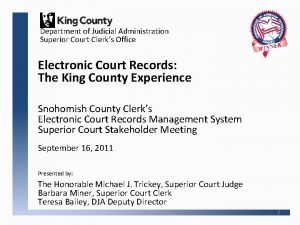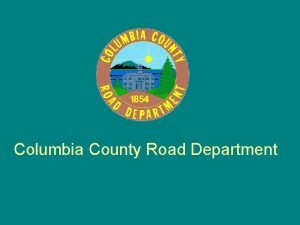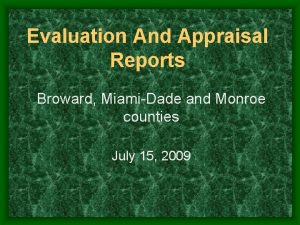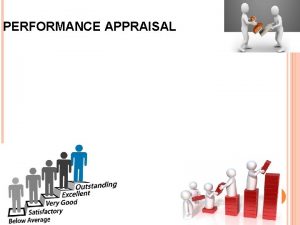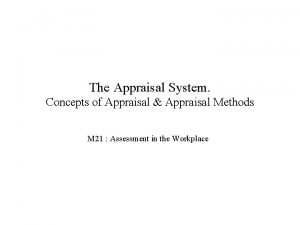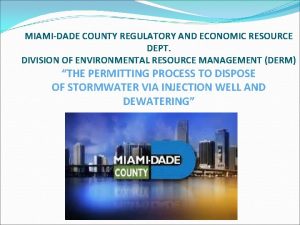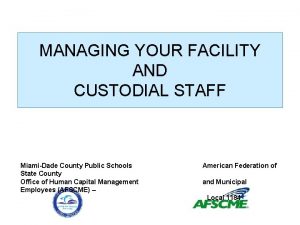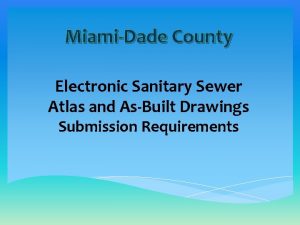Evaluation and Appraisal Report 2010 MiamiDade County Department














- Slides: 14

Evaluation and Appraisal Report 2010 Miami-Dade County Department of Planning and Zoning - pg 1

Presentation Overview § Introduction § What is the Comprehensive Plan? § What is an EAR? § What is a Major Issue? § Possible Major Issues § Public Discussion § EAR Process Timeline Miami-Dade County Department of Planning and Zoning - pg 2

What is the Comprehensive Plan? Elements of the CDMP • • • Land Use Transportation Housing Conservation, Aquifer Recharge and Drainage Water, Sewer and Solid Waste Recreation and Open Space • • • Coastal Management Intergovernmental Coordination Capital Improvements Educational Element Economic Element Purpose of the CDMP Establishes Goals, Policies and Objectives addressing: • Land use & urban form • Natural resources conservation and use • Public services and facilities Miami-Dade County Department of Planning and Zoning - pg 3

Transportation Element GOAL DEVELOP AND MAINTAIN AN INTEGRATED MULTIMODAL TRANSPORTATION SYSTEM IN MIAMI-DADE COUNTY TO MOVE PEOPLE AND GOODS IN A MANNER CONSISTENT WITH OVERALL COUNTYWIDE LAND USE AND ENVIRONMENTAL PROTECTION GOALS. Objective TE-2 In furtherance of pedestrianism as a mode of transportation encouraged in the planned urban area, by 2008 Miami-Dade County shall enhance its transportation plans, programs and development regulations as necessary to accommodate the safe and convenient movement of pedestrians and nonmotorized vehicles, in addition to automobiles and other motorized vehicles. Policy TE-2 B. By 2008, the County shall develop a comprehensive countywide greenways network providing continuous corridors for travel by pedestrians and non-motorized vehicles incorporating elements of the adopted South Dade Greenway Network Master Plan and the North Dade Greenways Plan. Miami-Dade County Department of Planning and Zoning - pg 4

What is an Evaluation and Appraisal Report (EAR)? ● Evaluation of the Comprehensive Plan every 7 years ● An assessment of progress ● Identifies changes - Successes and failures - Conditions that affect the community - Statute and Growth Management policies ● Provides assessment of major issues Miami-Dade County Department of Planning and Zoning - pg 5

Identification of Major Issues What is a Major Issue? • It is an impediment that prevents a community from getting to where it wants to be in the future. • It is a problem that needs to be overcome before a community’s vision can be achieved. What is not a Major Issue • Localized/neighborhood problems • Topics that can be included into an evaluation of a single element and may require little policy change. • It can be a current controversy that is being widely discussed within the community Miami-Dade County Department of Planning and Zoning - pg 6

Possible Major Issues Miami-Dade County Department of Planning and Zoning - pg 7

Where and how do we grow? ● How do we balance our need to grow with the need to preserve our agricultural pr and natural resources? ● Will we need to expand the Urban Development Boundary (UDB)? ● How do we encourage redevelopment? ● Where will the growth occur? Will this growth be sustainable? Projections: ● Miami-Dade County’s population is projected to grow to over 3. 2 million by 2030 ● By 2018 the supply of vacant land within UDB available for residential growth is projected to be depleted (This does not account for redevelopment potential) ● 52, 000 acres of agricultural land are needed to maintain a viable agricultural industry: 57, 000 acres remain outside the UDB. Miami-Dade County Department of Planning and Zoning - pg 8

How will we get around? ● How do we create a transportation system that efficiently gets people from home to work and play? ● How do we design communities to encourage pedestrian and transit use? ● How do we reduce transportation related greenhouse gas emissions? Projections Before ● The number of automobiles are projected to increase by 48% by 2030 ● The number person trips are projected to increase by 40% by 2030 After Source: Miami-Dade Long Range Transportation Plan (to the Year 2030), Dec. 2004. The History of Miami-Dade Transportation. Miami-Dade County Department of Planning and Zoning - pg 9

Where will we work and live? • How will we accommodate the housing and employment needs of new residents? • How do we deal with foreclosures and declining housing values, while addressing the continued need for affordable housing? • How do we attract industries with higher paying jobs and where do we locate these industries? Projections • Population is projected to grow by 700, 000 people by 2030 • 250, 000 new housing units will be needed accommodate the projected population Miami-Dade County Department of Planning and Zoning - pg 10

Can our infrastructureaccommodate growth? ●Can our infrastructure and public services accommodate projected growth? ●Is there adequate infrastructure in the areas where we want to encourage development? ●As available land becomes more limited, where do we locate new facilities? ●How will we pay for future infrastructure improvements and on-going maintenance with limited resources? ●Does the County’s capital improvement plan reflect the goals of the CDMP? Projections ●Wastewater discharge into the Atlantic Ocean must be eliminated by 2025 ●Need additional landfill and solid waste disposal capacity ●Resources for ongoing maintenance of existing infrastructure (roads, parks, greenways) are not adequate to accommodate future growth Miami-Dade County Department of Planning and Zoning - pg 11

How will climate change affect us? • How do we plan for the possible impacts of climate change? Projections • Sea level is projected to rise as much as five feet by the end of the century • Miami is ranked 1 st in the world for assets most likely to be exposed to coastal flooding by 2070 --with a projected cost of $3. 5 trillion. • Miami is ranked 9 th in the world for population most likely to be exposed to coastal flooding by 2070. Source: Miami-Dade climate Change Advisory Task force Science Committee and Ranking of the world’s cities most exposed to coastal flooding today and the future. Miami-Dade County Department of Planning and Zoning - pg 12

Town Hall Meeting Ground Rules Agenda Introduction – 6: 00 to 6: 30 p. m. • Visit different stations. Staff will be available to answer questions Public Input on Issues – 6: 30 to 8: 00 p. m. • Add your “Major Issue” to the suggested list provided by Staff Conclusion – 8: 00 to 8: 30 p. m. • Focus on “Major Issues” • Comment sheets/handouts are available for other concerns that are not “Major Issues. ” Please provide Comment sheets/handouts to staff. What is a Major Issue? Thank you for participating! • It is an impediment that prevents a community from getting to where it wants to be in the future. • It is a problem that needs to be overcome before a community’s vision can be achieved. • It can be a current controversy that is being widely discussed within the community Miami-Dade County Department of Planning and Zoning - pg 13

EAR Process and Timeline Deadline for Adoption: Nov. 1 st, 2010 Tentative Timeline EAR PROCESS July 2009 to February 2010 1. Meetings with County Agencies August to September 2009 2. Public Workshops to identify Issues October 2009 3. Scoping Meeting with State, Regional & Local Agencies November 2009 4. Letter of Understanding to DCA with final list of Issues May 2010 5. Publish proposed EAR July 2010 6. PAB Public hearing to review proposed EAR Before August 1, 2010 7. Transmit proposed EAR to BCC and DCA for optional review September 2010 8. DCA Review (30 days) October 2010 9. BCC Public hearing to adopt the EAR Late Oct 2010 10. Transmit Adopted EAR to DCA Late December 2010 11. DCA provides preliminary sufficiency determination Late January 2011 12. DCA issues final sufficiency determination 18 months from EAR Sufficiency 13. EAR Based Amendments Miami-Dade County Department of Planning and Zoning - pg 14
 Bidsync through miamidade county
Bidsync through miamidade county Nicki brisson
Nicki brisson A 540 degree appraisal involves evaluation by
A 540 degree appraisal involves evaluation by Grayson county texas appraisal district
Grayson county texas appraisal district Appraisal report example
Appraisal report example Narrative appraisal report sample
Narrative appraisal report sample Milwaukee county department of health and human services
Milwaukee county department of health and human services Barnstable county department of health and environment
Barnstable county department of health and environment Wakulla county rec park
Wakulla county rec park Sotch orange
Sotch orange 204 e holly ave sewell nj 08080
204 e holly ave sewell nj 08080 Fresno county probation ab109
Fresno county probation ab109 King county e filing
King county e filing Cowlitz county health department
Cowlitz county health department Columbia county road department
Columbia county road department



